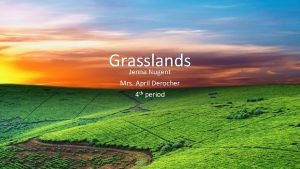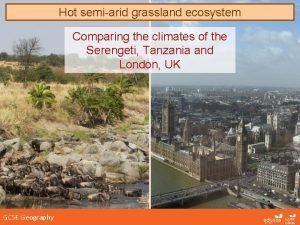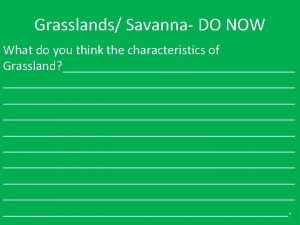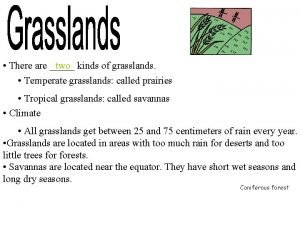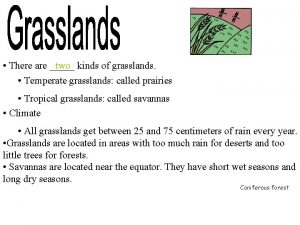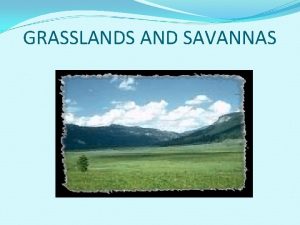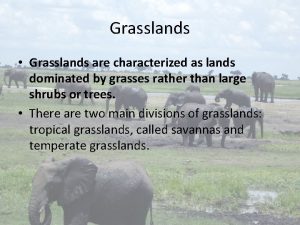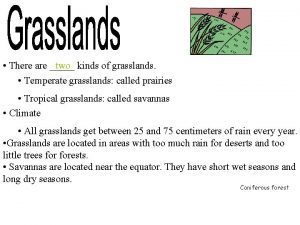Grasslands Jenna Nugent Mrs April Derocher 4 th









- Slides: 9

Grasslands Jenna Nugent Mrs. April Derocher 4 th period

Grassland Biome • Locations: North America, South America, Europe, Africa, Asia and Australia Grassland biomes consist of grand rolling terrain of grasses, flowers and herbs. They are found in the middle latitudes of the innermost of continents. Grasslands are know for the most widespread of all types of vegetation of the world. The soil is too thin and dry for trees to thrive. Grasslands can survive fire due to the fact they grow from the bottom instead of the top. Grasslands consist of two different types. Tall-grass are found in wet and humid areas. Short-grass are found in dry areas with hot summers and cold winters.

Abiotic Features Temperature: Grassland climates varies on different regions. Tropical grasslands can range from 59 to 95 degrees Fahrenheit. Temperate grasslands range from 0 to 82 degrees Fahrenheit. Precipitation: The average rainfall for the temperate grasslands can range 10 -30 inches. The tropical and subtropical grasslands range from 25 -60 inches. Plant growing depends on the amount of precipitation and the current temperature. Plants usually begin growing when it becomes 50 degrees Fahrenheit. They are dormant during colder temperatures usually for 100 to 175 days. Landforms: Grasslands have steppes, hills and mountains near the edges. Deserts and plateaus are found in the Savannah grassland borders. Bodies of Water: Grasslands contain ponds, lakes, streams, rivers and wetlands.

Biotic features for Grassland Biome June Grass June grass is found in the prairies of Midwestern USA. This grass prefers sandy soil and areas where there it has at least 10 inches of rain. It has a strong root system. Live stock and wild animals graze on this grass. Buffalo Grass Buffalo grass grows mostly in the North American prairies. It grows 2 to 5 inches and up to 12 feet wide. Livestock, white-tailed deer, buffalo, pronghorns, jackrabbits, and prairie dogs eat Buffalo grass. Badger The badger is a carnivore. They live for an average of 20 years. They eat small mammals, lizards, snakes, insects, and carrion. Badgers have poor eyesight. They relay on sense of smell. Badgers have no natural predators. Bobcat Stinging Nettle is a dangerous plant found in Europe and the USA. When you touch this plant you will get a painful sting comparable to a bee sting. The sting can last hours and possibly days. Stinging Nettle can grow as high as 4 feet. Bobcats can run up to 30 miles per hour but they prefer to walk. They eat rabbit, squirrel, ground nesting birds, turkeys, and small deer. Bobcats can weigh about 33 pounds. Coyotes are in the dog family. They are omnivores. They eat rabbits, birds, gophers, prairie dogs, rats, and fruits. Coyotes are smart and have a great hearing system. Prairie Dogs are cousins to the squirrels. They eat mostly grasses, herbs, grasshoppers and insects. Prairie dogs live in burrows. Bumble Bee Bald Eagles are the national bird for the USA. They eat dead animals, chickens and fish. Bald Eagles hunt in pairs and will steal from the other species. Bumble Bees make their homes in the underground nests of small animals like mice. Bees carry pollen from flower to flower. They are important because they fertilize and pollinate different flowers in the area. They are harmless unless provoked. They will sting. Bumble Bees are hunted by birds and skunks.

Predator-prey relationships Prairie Dogs are very important on the prairie. They maintain the grasslands by cutting down large weeds and brush while establishing their burrows. Their abandon burrows are often used by the rabbits, hares, Burrowing Owl, Black-footed Ferret and the Texas Horned Lizard. These animals are prey to the coyotes. Badgers are fearless hunters in the grasslands. They have no natural predators but they hunt mostly small mammals, insects, lizards and carrion. Badgers are one of the only mammals to hunt and eat rattle snakes The Bumble Bees are super important for the grasslands. They help fertilize plants and flowers in the grasslands. Bumble Bees do have to watch out for predators. Birds and skunks hunt them for prey. Bobcats are predators and also prey. Cougars and pumas hunt them. Humans also hunt them for their fur. Bobcats hunt their prey at night. Their meal of choice is rabbits but they also eat rats, turkeys, ground nesting birds, squirrel, and small deer.

Plant and Animal adaptions Stinging Nettle Buffalo Grass • They have adapted stinging cells to ward off herbivores from eating. • They also have a Dock leaf sap that contains oxalic acid. This too refrains them from predators. • Buffalo grass has adapted to be a tuff, thick grass that survives from insect infestation. • It also has long root structures that is able to get nutrients and water from other areas Yak Prairie Dog • Yaks live in the temperate grasslands. They have adapted a thick coat of hair to keep warm in the winter. • They also use their horns and hooves to break the ice to be able to eat grass below. • Prairie Dogs have adapted by burrowing holes to escape from predators in the ground. Sharp claws and teeth allow them to dig faster and easier. • They also adapted the ability to store food in their cheeks.

Ecological issues and concerns One Fourth of the earth used to be covered by grasslands. Humans have impacted grasslands by converting them into farms. Grazing livestock have damaged grasslands. Grasslands are also subject to wildfires, extensive mowing , and urban development. These catastrophic events has caused widespread loss of wild life habitat and now North America has approximately 5 percent of prairies. • • Grassland Threats Global warming can cause grasslands into deserts. Grasslands converting into row cropping. Certain plant tolerant varieties taking over native grasslands. When one crop farms are grown it causes potential toxic pesticides needed to ward off pests and diseases. Grassland Solutions • There needs to be continuing education on how to prevent soil erosion and how to protect the soil. • Wetlands need to be protected because they play a great role in the ecology of the grasslands. • Trees need to be plant around the margins of grasslands to help as windbreaks. • Grasslands need to have dry season burning to aide in the restoration of calcium in the soil and to maintain fresh soil.

Bibliography M. , S. (2000). Grasslands Biome. Retrieved September 17, 2016, from http: //www. blueplanetbiomes. org/grasslands. htm Landforms. (n. d. ). Retrieved September 18, 2016, from http: //gloria 101. weebly. com/landforms. html S. , B. (2001). Grassland Animals. Retrieved September 18, 2016, from http: //www. blueplanetbiomes. org/grasslands_animal_page. htm Badger, used image too S. , B. (2001). Grassland Animals. Retrieved September 18, 2016, from http: //www. blueplanetbiomes. org/grasslands_animal_page. htm Bobcat, used image too Smith, J. M. (n. d. ). Grassland. Retrieved September 17, 2016, from https: //www. britannica. com/science/grassland G. , C. (2000). Grassland Plants. Retrieved September 17, 2016, from http: //www. blueplanetbiomes. org/grasslands_plant_page. htm Stinging Nettle, used image Plants. (n. d. ). Retrieved September 18, 2016, from http: //gloria 101. weebly. com/plants. html N. , J. (2001). Grassland Plants. Retrieved September 17, 2016, from http: //www. blueplanetbiomes. org/grasslands_plant_page. htm June Grass, used image UK Plant Science Status Report. (n. d. ). Retrieved September 18, 2016, from http: //www. saps. org. uk/secondary/teaching¬resources/869¬investigating¬leaf¬adaptations¬w hy¬do-nettles¬sting Google Images. (n. d. ). Retrieved September 17, 2016, from https: //www. google. com/imgres? imgurl=http: //siwekbiome. weebly. com/uploads/9/0/6/5/90 65220/320112393_orig. jpg? 351 B. , J. (2000). Grassland Animals. Retrieved September 18, 2016, from http: //www. blueplanetbiomes. org/grasslands_animal_page. htm Bald Eagle, used image too Grasslands Threats. (n. d. ). Retrieved September 18, 2016, from http: //environment. nationalgeographic. com/environment/habitats/grassland-threats/ F. , L. (2000). Grassland Animals. Retrieved September 18, 2016, from http: //www. blueplanetbiomes. org/grasslands_animal_page. htm Coyote, used image too F. , L. (2000). Grassland Animals. Retrieved September 18, 2016, from http: //www. blueplanetbiomes. org/grasslands_animal_page. htm Prairie Dog, used image too B. , S. (n. d. ). Grassland Animals. Retrieved September 18, 2016, from http: //www. blueplanetbiomes. org/grasslands_animal_page. htm Bumble Bee, used image too Grassland Plants. (2000). Retrieved September 21, 2016, from http: //www. blueplanetbiomes. org/grasslands_plant_page. htm Buffalo Grass, used image Animals. (n. d. ). Retrieved September 18, 2016, from http: //gloria 101. weebly. com/animals. h Yak, Prairie Dog

Bibliography Source 1: Grasslands Author: Sam B. Main Pages Used: 1 -2 Online Source 2: Grasslands: Temperate Grassland Animals Author: Unknown Main Pages Used: 1 Online Source 3: Encyclopedia Britannica-Grasslands Author: Unknown Main Pages Used: 1, 3, 5 Online Source 4: National Geographic- Grassland Threats Author: Unknown Main Pages Used: 1 Online Source 5: Blue Planet Biomes Grasslands Animal Bald Eagle Author: Jai B. Main Pages Used: 1 Online Source 6: Blue Planet Biomes Grasslands Animal Badger Author: Ben S. Main Pages Used: 1 Online Source 7: Blue Planet Biomes Grasslands Animal Coyote Author: Lauren F. Main Pages: 1, 2 Online Source 8: Blue Planet Biomes Grasslands Animal Prairie Dog Author: Lauren F Main Pages: 1, 2 Online Source 14: Grasslands: Temperate Grassland Animals Author: Unknown Main Pages: 1 Online Source 9: Blue Planet Biomes Grasslands Animal Bumble Bee Author: Sarah B. Main Pages: 1, 2 Online Source 14: Grasslands: Plant Life in Temperate Grassland Author: Unknown Main Pages: 2 Online Source 10: Blue Planet Biomes Grasslands Animal Bobcat Author: Ben S Main Pages: 1 Online Source 15: Investigating leaf adaptions-why do nettles sting? Author: Unknown Main Pages: 1 Online Source 11: Blue Planet Biomes Grasslands Plant Stinging Nettle Author: Celeste G. Main Pages: 1 Online Source 12: Blue Planet Biomes Grasslands Plant June Grass Author: Jon N. Main Pages: 1 Online Source 13: Blue Planet Biomes Grasslands Plane Buffalo Grass Author: Unknown Main Pages: 1 Online
